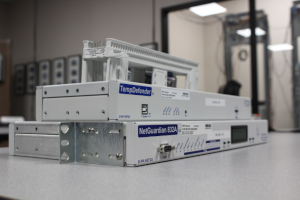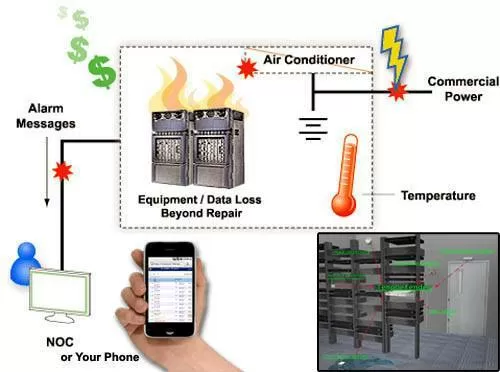Download our free Monitoring Fundamentals Tutorial.
An introduction to Monitoring Fundamentals strictly from the perspective of telecom network alarm management.
1-800-693-0351
Have a specific question? Ask our team of expert engineers and get a specific answer!
Sign up for the next DPS Factory Training!

Whether you're new to our equipment or you've used it for years, DPS factory training is the best way to get more from your monitoring.
Reserve Your Seat TodayDo you have mission-critical gear and sensors to monitor at your distant remote sites?
It's unacceptable for your customers to know about a problem with your equipment before you do. Without a man stationed at each of your remote sites, how can you possibly know the status of your equipment?
What is a remote monitoring system? It is a networked system that allows you to manage devices from a remote location.
These monitoring systems automate processes and boost efficiency by providing reliable, remote visibility over critical equipment and environmental conditions. In industries where uptime is essential, such as telecommunications and utilities, a single moment of oversight can lead to costly downtime. Through constant monitoring of network elements, environmental factors, and equipment status, the system allow teams to proactively address issues before they escalate. For instance, by monitoring battery levels, temperature, and equipment health, these systems enable quick, data-driven responses that prevent failures, reduce the need for manual site visits, and optimize resource allocation.
Moreover, remote management and control systems significantly enhance business operations by automating audit trails and logging staff and system actions. This streamlining not only increases operational speed but also ensures safety by delegating tedious and potentially dangerous tasks to automated systems. These systems empower staff to concentrate on tasks that require skilled human intervention, thereby maximizing productivity and expertise.
Importantly, remote monitoring and control systems do not require a complete overhaul of existing processes. Instead, they seamlessly integrate with current operations, enhancing the way businesses function today.
Building a reliable Remote Monitoring System doesn't mean starting from scratch. Many of your existing network devices likely have monitoring features you're not fully utilizing. By integrating these capabilities into a centralized platform like a T/Mon or NetGuardian system, you can collect various inputs and alarms and gain clearer, actionable insights into your network's health.
Success in remote monitoring hinges on aligning tools, teams, and processes. A well-implemented strategy centralizes network intelligence, enabling smarter responses with fewer site visits. Consider DPS Telecom's Building Access System (BAS), which enhances site security by integrating access control and real-time notifications for unauthorized entries.
Maximizing remote monitoring potential means leveraging existing infrastructure while adding best-in-class tools where needed. With DPS Telecom's scalable solutions, you'll strengthen operational efficiency, reduce costs, and stay prepared for future growth. Contact us today to explore how a custom-fit Remote Monitoring System can empower your network.
By deploying remote monitoring equipment at your sites, you'll now have the visibility you need to monitor and control your network. As your company's network operator, you need to be the first to know about an emergency. Nobody can afford to periodically check their equipment when they have multiple remote locations.

With proper remote monitoring techniques, you'll be able to respond to network problems and fix them before they cause serious damage. You have to use the right monitoring solution. Choosing a poorly designed or limited system will only trick you into a false sense of security. You'll think your network is protected, but in reality, your limited solution is leaving you vulnerable.
In your remote monitoring system, it's important that you have a competent remote monitoring and management (RMM) software. RMM tools are responsible for making sure you are always aware of the health and status of your remote equipment.
So, if you want the best monitoring system, then you'll want to look for - at a minimum - these 5 essential features:
Building a remote monitoring system takes more than just installing new hardware, it requires a well-planned strategy. Here's a clear, actionable approach to streamline your asset management processes while improving network visibility.
1. Pinpoint What You Need to Monitor
Start by identifying the most critical assets and workflows that need oversight. Focus on processes like equipment checkouts, returns, and asset status updates. Decide which data points matter most. Think late returns, damaged equipment reports, and usage logs. The clearer your monitoring targets, the easier it will be to manage operations.
2. Assign Roles and Define Access
Determine who will interact with the system and outline their responsibilities. Specify which team members will handle checkouts, track usage, and respond to system alerts. Clear role definitions ensure that the right people receive the right notifications, making the entire operation smoother and more efficient.
3. Leverage Existing Tech for Integration
Look at the tech you already have, many systems come with built-in monitoring features. You may not need a full system overhaul. Reorganize what you have and consider upgrades like smart lockers or key management systems to simplify tracking and control. With the right integration, your remote monitoring system can enhance productivity without disrupting existing workflows.
Picture how much easier managing your network will be if you're able to view the status of all your sites. With a remote monitoring system, you'll no longer have rude surprises when there's a problem with your network. You can guarantee you'll be the first person to know about an emergency - not the last.
You're serious about protecting your network up-time (and your bottom line). Don't let your remote monitoring project turn into a nightmare - contact us at DPS Telecom for a free consultation. We'll answer your questions and help you design a monitoring solution for your network.
Helpful Links:
How A Remote Control Monitor Will Prevent Outages And Save You Money
Reduce Truck Rolls for Cost Savings